II. User's Guide to the WISE Preliminary Data Release
3. Atlas Images
c. Image Anomalies and Features
Users of the image products are referred to the following links, which highlight examples of anomalies found in the WISE imaging data.
Note: There is a similar set of image anomalies for single-exposure images in II.4.a.ii.
i. Atlas Image Examples
Each figure below shows two rows of images. From left to right in the top row are shown the full Atlas images for W1, W2, W3, W4, and a three-color image comprised of W1(blue)+W2(green)+W3(red). From left to right in the bottom row are the coverage maps for W1, W2, W3, and W4, with the final image in this row being a three-color composite of the full Atlas images having W2(blue)+W3(green)+W4(red). The greyscale stretch in the coverage maps goes from black for a coverage of four or fewer frames up to white for the maximum coverage in the image. This maximum coverage value can vary depending on factors such as ecliptic latitude and the quality scores of the input frames.
Click on the thumbnails to see the images at higher resolution. Readers are encouraged to use the WISE image service at IRSA to preview these same images and to download the FITS files for further study. To aid the reader, values of the coadd_ID are provided in the caption of each image set below.
Image examples below are divided into the following categories:
Anomalies:
Latents:
Smeared latents from twist near the ecliptic poles
Smeared latents from moving objects
Features:
Low coverage:
Poorly covered areas near some bright stars
"Tiger-claw" scratches caused by Mars
Odd patterns:
Variable cirrus, changing zodiacal backgrounds, and scattered Moonlight
Bleed-through of satellite trails
Anomalies: Anomalies originate from the behavior of the arrays themselves and are not astrophysical.
Latents: Normal latents
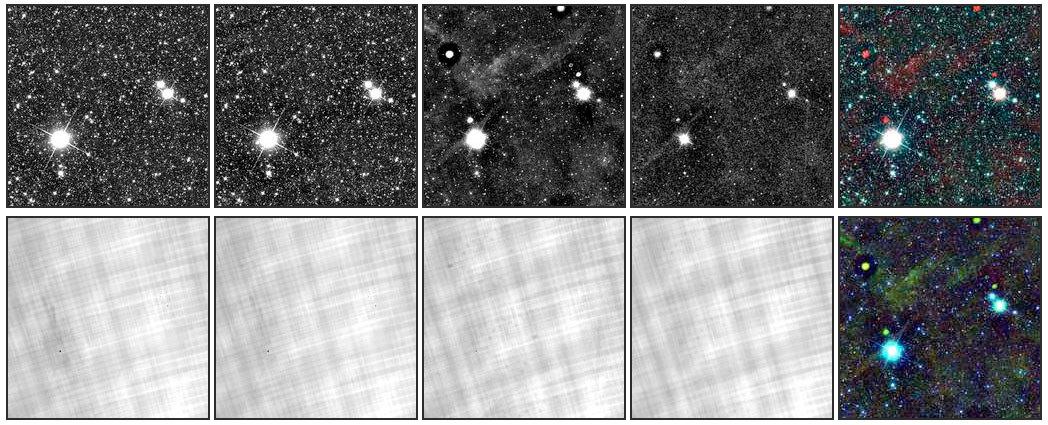 |
| Figure 1 - Atlas image 1034m485_aa11. Latents from bright stars in the Preliminary Release will usually coadd constructively because the star is always observed in the same scan direction and its latent sources will fall at or very near the same point on the sky (unless the star is near the ecliptic poles). In this example, the two bright stars near the center of the image create a trail of latents extending up and to the left. |
Latents: Monster latents
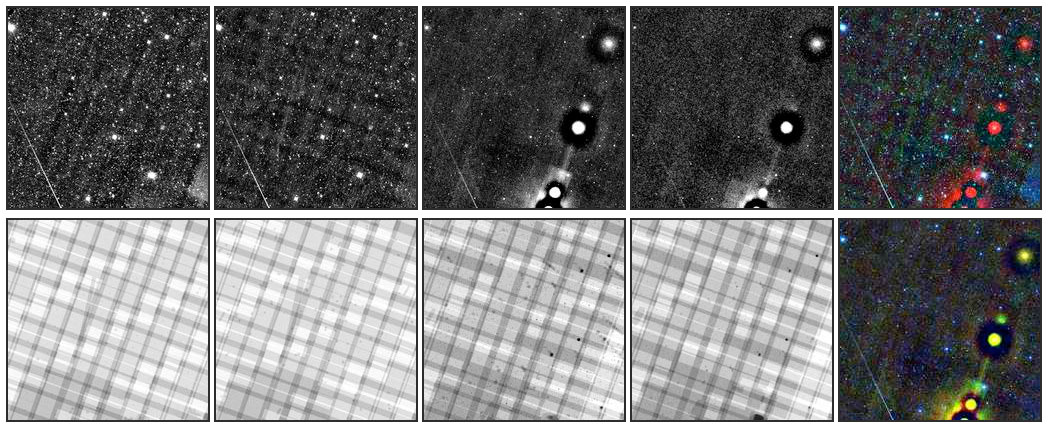 |
| Figure 2 - Atlas image 0347m016_aa11. Latents from bright stars in the Preliminary Release will usually coadd constructively because the star is always observed in the same scan direction and its latent sources will fall at or very near the same point on the sky (unless the star is near the ecliptic poles). In this example, an extremely bright star leaves an interesting trail of latents, ghost images, and latents from the ghosts themselves. |
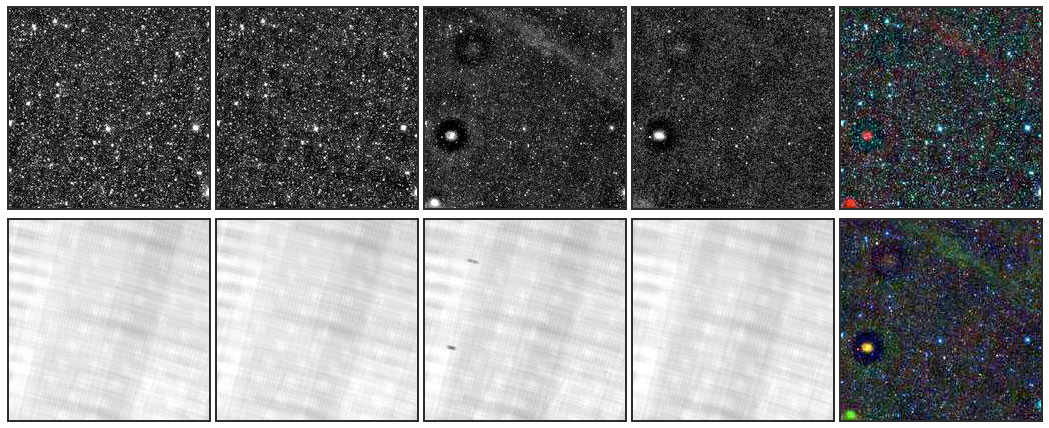 |
| Figure 3 - Atlas image 0763m470_aa11. Latents from bright stars in the Preliminary Release will usually coadd constructively because the star is always observed in the same scan direction and its latent sources will fall at or very near the same point on the sky (unless the star is near the ecliptic poles). In this example a trail of decaying latents is seen. See also the dark holes and rings left by latents in Figure 6 and Figure 7.
|
Latents: Smeared latents from twist near the ecliptic poles
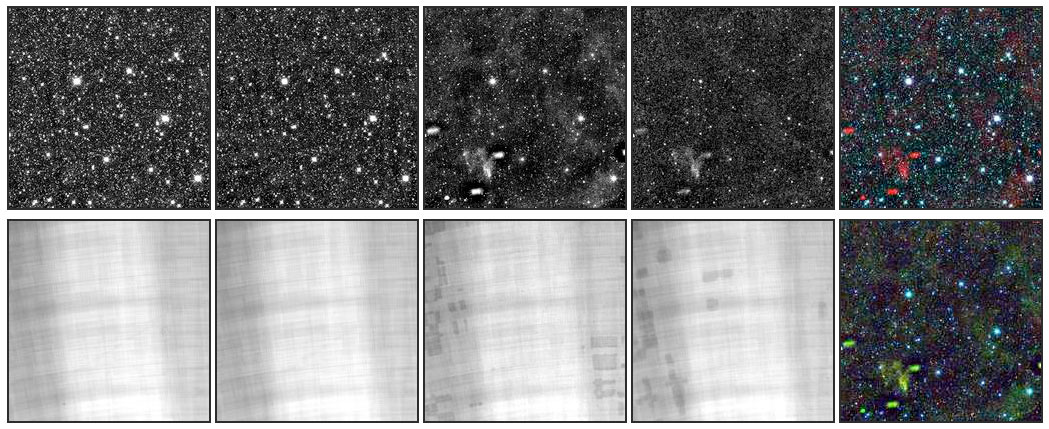 |
| Figure 4 - Atlas image 0921m591_aa11. Latents from bright stars in the Preliminary Release will usually coadd constructively because the star is always observed in the same scan direction and its latent sources will fall at or very near the same point on the sky (unless the star is near the ecliptic poles). In this example, three bright stars just off the bottom of the frame leave latents in the lower left quadrant of W3/W4
that are arc-shaped in the final coadds. Because the change in scan angle from earliest to latest frame is still small, outlier rejection during the coaddition process does not completely remove the latent signature. |
Latents: Smeared latents from moving objects
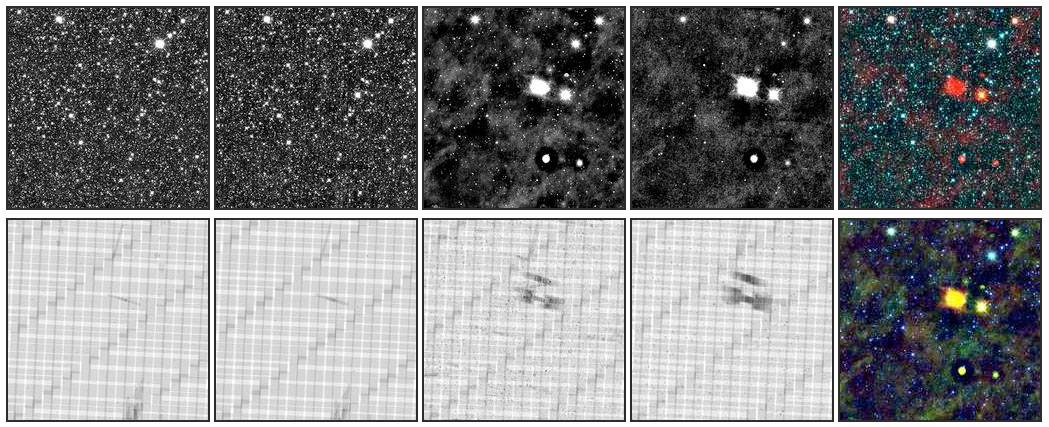 |
| Figure 5 - Atlas image 0832p196_aa11. Bright asteroids can also leave latents. If the asteroid is moving
slowly enough, outlier rejection during the coaddition process will not completely remove the latent signature,
leaving a smudgy artifact. In this example, the asteroid (seen near the center of the image as the W3/W4-bright object)
leaves a slightly extended latent artifact at lower right. |
Other bright star effects: Reflections
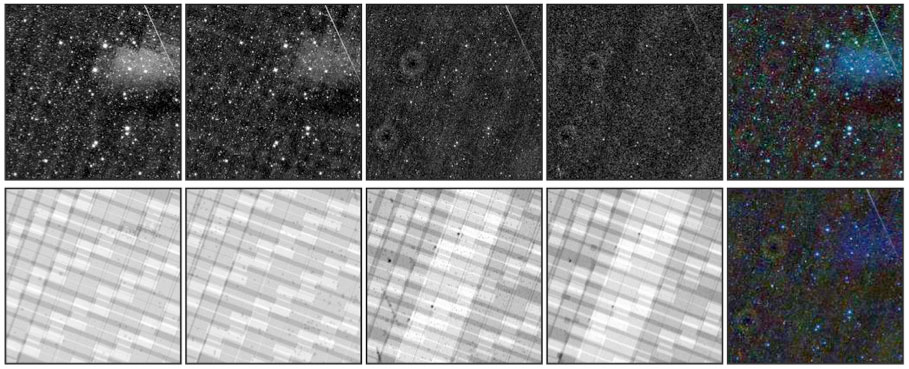 |
| Figure 6 - Atlas image 0349m046_aa11. The diffuse glow in the upper
right is caused by constructive coaddition of "half-frame" glows
from the bright star Mira, just off the top of this field. See
Figure 3 for more on the dark holes and rings seen here.
|
Electronic artifacts: Diagonal striping pattern
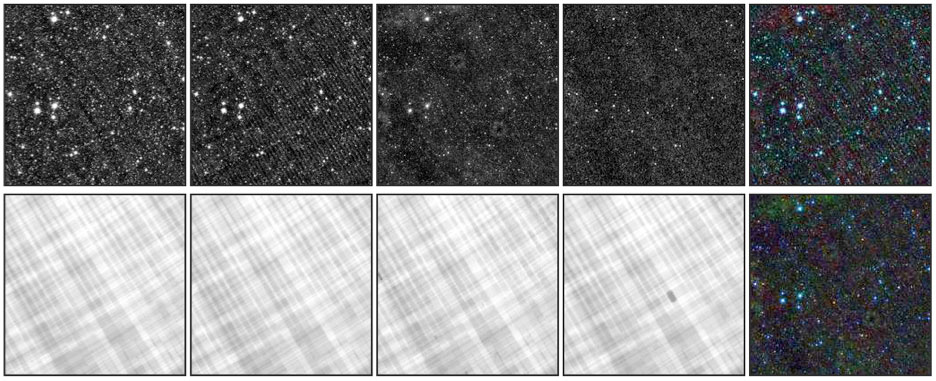 |
| Figure 7 - Atlas image 2392p499_aa11. Electronic noise can sometimes constructively coadd to produce effects such as the diagonal pattern seen here at W2. See Figure 3 for more on the dark holes and rings also seen here. |
Features: Features are caused by real, astrophysical objects or poor coverage and may look like anomalies.
Low coverage: Holes in the images
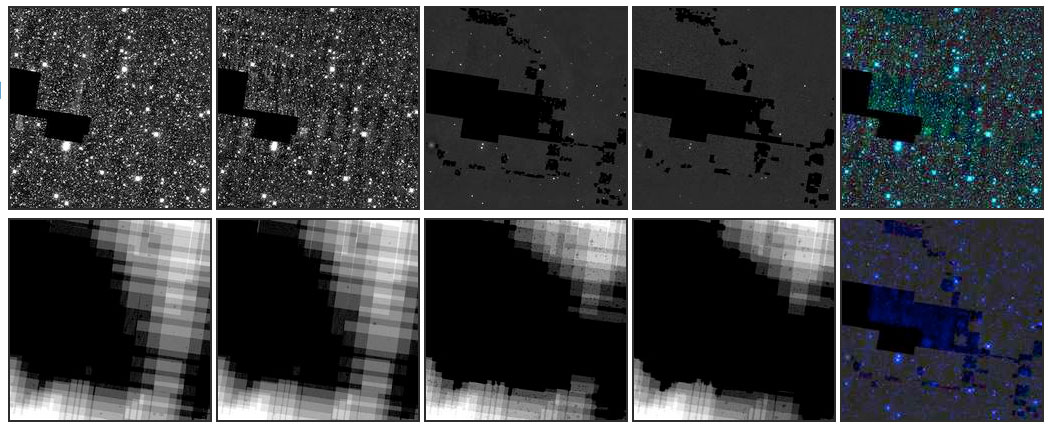 |
| Figure 8 - Atlas image 0753p696_aa11. Some areas of sky contained within the footprint of the Preliminary Release
are not covered by any high-quality frames. In this example, the areas shown in black in all four bands are areas with
no coadded data. The user is encouraged to check the single-exposure frames in these instances if data in these areas
are needed.
|
Low coverage: Frame-level NaNs
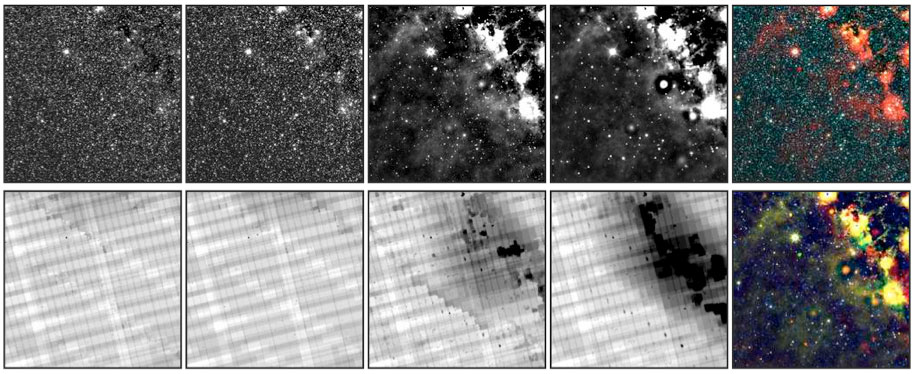 |
| Figure 9 - Atlas image 2400m546_aa11. When frames lack data due to NaNs ("Not-a-Number" values), the resulting
coadds will also contain holes. In this example, a bright nebula has saturated the individual frames, so parts of
the coadd lack any valid data. |
Low coverage: Poorly covered areas near some bright stars
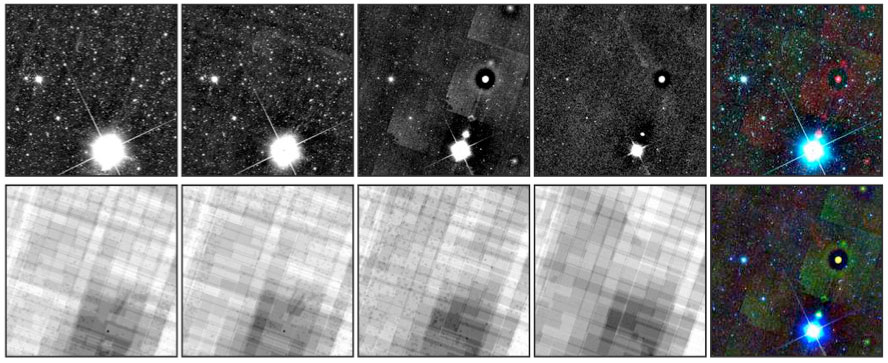 |
| Figure 10 - Atlas image 0500m213_aa11. Diffraction spike artifacts from very bright stars in regions of low stellar density
sometimes trigger poor image metrics because bogus sources dominate the statistics. Before this effect was
understood, the automated scoring was not overridden in these cases and some frames would receive low quality
scores as a result. In these instances, such as the one shown here, an area of shallower coverage was created around the
bright star. |
Low coverage: "Tiger-claw scratches" caused by Mars
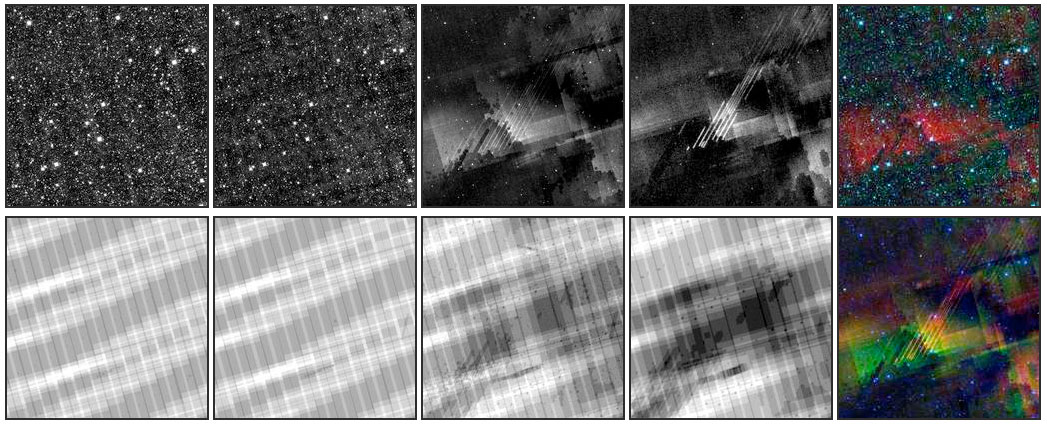 |
| Figure 11 - Atlas image 1323p212_aa11. When frame coverage drops to four or below, outlier rejection is unable to
remove single-frame-only anomalies. In the example shown here, diffraction spikes from Mars, which marched slowly
across the field as the WISE data were taken, were imprinted into the W3 and W4 images as a series of parallel streaks.
(For an explanation of the non-uniform backgrounds in W3 and W4, see Figure 12.) |
Odd patterns: Variable cirrus, changing zodiacal backgrounds, and scattered Moonlight
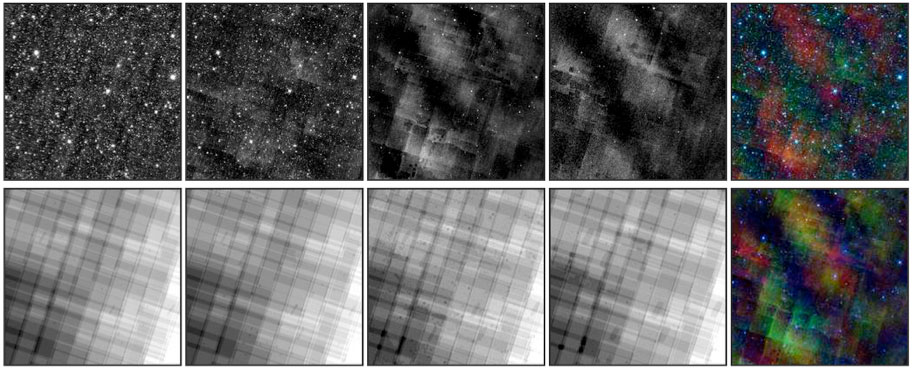 |
| Figure 12 - Atlas image 0423m016_aa11. Changes in the W3/W4 backgrounds can be caused by a number of factors including
varying zodiacal light, infrared cirrus, or scattered light from the Moon. As with the example shown here, such changes can imprint frame
edges into the coadds, particularly when coverage is low. |
Odd patterns: Bleed-through of satellite trails
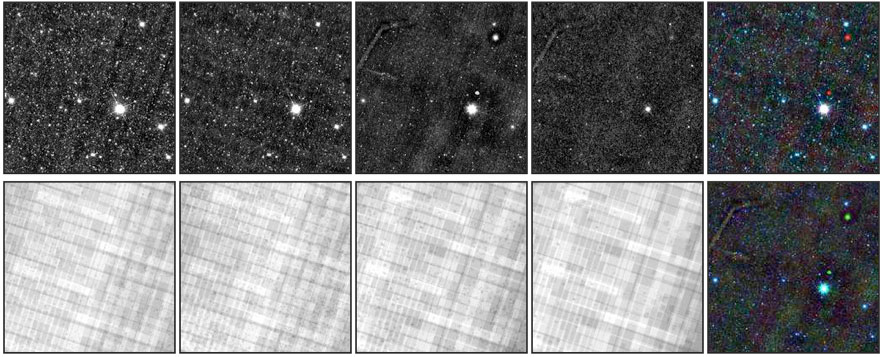 |
| Figure 13 - Atlas image 0512m197_aa11. Fainter, one-frame-only events such as the passage of a satellite during
scan mirror fly-back will not trigger outlier rejection during the
coadd generation step. In such cases, as with the latent from a kinked satellite trail seen in W3 and W4 here, these
one-time-only events may imprint into the Atlas images. |
Slowly moving sources: "Blob" caused by planet
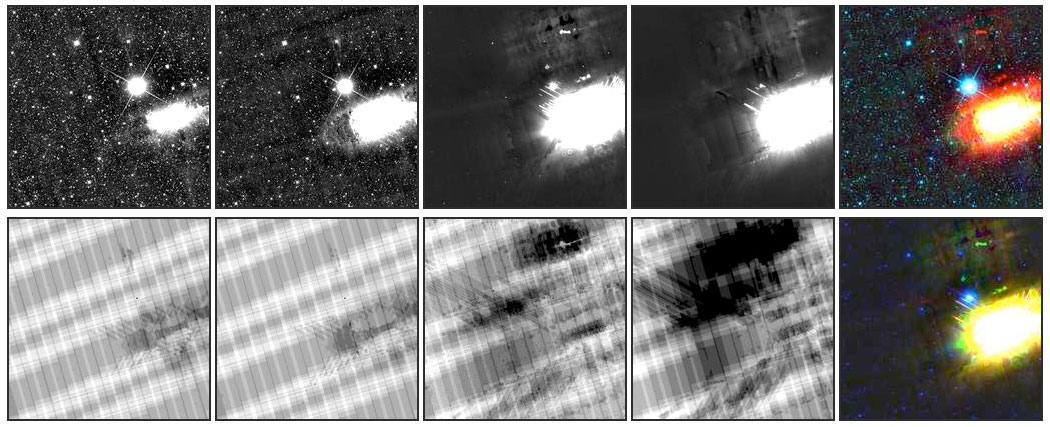 |
| Figure 14 - Atlas image 1344p196_aa11. Slowly moving sources will not be fully removed during the outlier
rejection step of coadd generation. In this example, the planet Mars is smeared across the
right side of the image. |
Slowly moving sources: "Blob" caused by comet
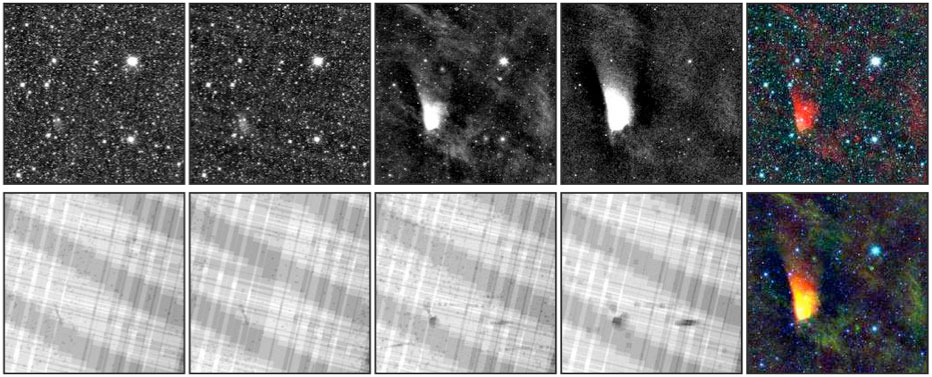 |
| Figure 15 - Atlas image 3043m303_aa11. Slowly moving sources may not be properly removed during the outlier
rejection step of coadd generation. In this example, comet 164P/Christensen creates a smear
along the left side of the image. |
Slowly moving sources: Streaks caused by asteroid
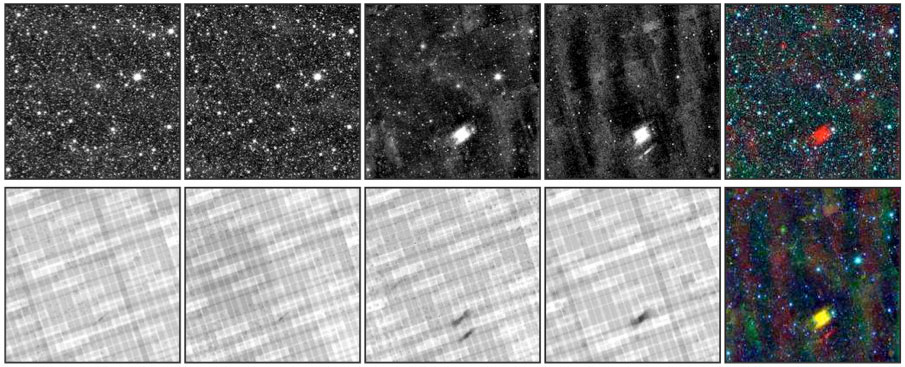 |
| Figure 16 - Atlas image 2213m334_aa11. Slowly moving sources may not be properly removed during the outlier
rejection step of coadd generation. In this example, an asteroid and its ghost are imprinted onto the coadds as
a parallel blob and streak. |
Real sources: Comet debris trails
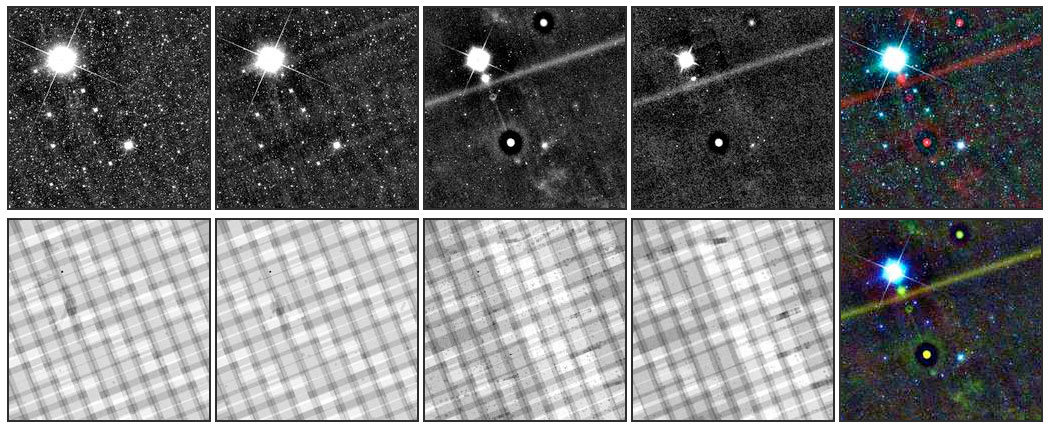 |
| Figure 17 - Atlas image 2028m076_aa11. Comet debris trails will also appear
in the images since these appear in the single-exposure images. These may smear out slightly in the Atlas images because of
parallax: WISE's Earth-based vantage point changes slightly from frame to frame because these objects are very nearby. (The
bright star and well as others off the field have also left latents as described in
Figure 2 and Figure 3.)
|
Real sources: Bubbles and shells
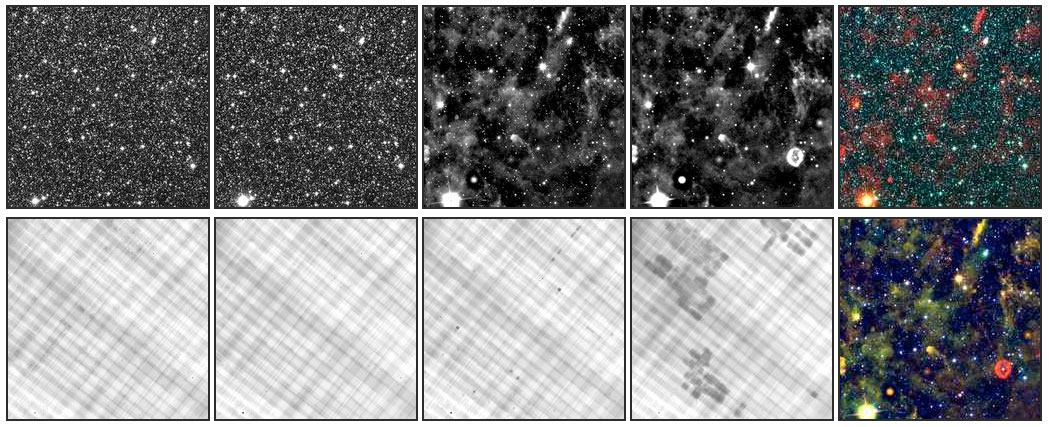 |
| Figure 18 - Atlas image 1677m652_aa11. Bubbles and shells seen
in the single-exposure frames will, of course, also appear in the Atlas images and may mimic an artifact. In
this example we see a W4-bright shell around the Wolf-Rayet star WR40. |
Last update: 2011 March 11
Previous page Next page
Return to Explanatory Supplement TOC

















